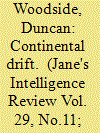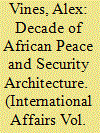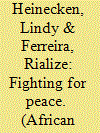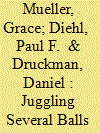|
|
|
Sort Order |
|
|
|
Items / Page
|
|
|
|
|
|
|
| Srl | Item |
| 1 |
ID:
156017


|
|
|
| 2 |
ID:
119440


|
|
|
|
|
| Publication |
2013.
|
| Summary/Abstract |
This article examines how the African Union (AU) has handled Africa's peace and security challenges since 2002, defines what has been successful and what remains aspirational. It does so by examining how the AU has responded, from using sanctions against coups, to deploying peacekeeping missions and mediating in conflicts.
An African Peace and Security Architecture (APSA) has developed since 2002, including a Peace and Security Council, an African Standby Force, a Continental Early Warning System and a Panel of the Wise. This sounds impressive, but the operationalization record is patchy: AU-deployed missions have been fully dependent on external donors; harmonization is a major problem; serious questions remain over AU capacity; and some of the Regional Economic Communities (RECs) are developing at a quicker pace than the AU.
Given these circumstances and its internal capacity deficit, the AU will likely struggle to exercise oversight of regional processes, including the development of regional standby force arrangements. APSA is clearly based on a liberal peace model, yet democratic systems, respect for human rights and good governance aren't always in place in African countries, and the self-interest of elites continues to be a constraint on APSA and its success.
Over the last decade the AU has found a voice and, despite some setbacks, it has shown through AMISOM in Somalia that it is capable of conducting a successful peacemaking operation. Its biggest challenge is not making the decision to intervene or deploy forces, but the capacity of most African states to deploy effectively. APSA's dependence on external partners needs to diminish over the next decade if better African solutions are to be found to peace and security challenges in the continent. Yet, the internationalized nature of crises such as the one in Mali in 2012-13 requires international partnerships.
Not all of Africa's security problems can be solved by Africa alone, but APSA does provide a vision framework for African and external partnership.
|
|
|
|
|
|
|
|
|
|
|
|
|
|
|
|
| 3 |
ID:
113322


|
|
|
|
|
| Publication |
2012.
|
| Summary/Abstract |
This article reports on the experiences of South African military personnel who have been deployed on peace missions in Burundi, the DRC and Darfur/Sudan. These missions are extremely challenging for peacekeepers given the complex, vicious and protracted nature of the conflicts in these countries. This has placed heavy demands on individuals participating in field operations, not only because the operations are often dangerous and unpredictable, but also because of the conditions under which they have to serve and the resources available to them. In this study, the experiences of 94 SANDF personnel who have been deployed primarily in Burundi, the DRC and Sudan are analysed in relation to their operational experiences; the challenges posed by the rules of engagement; shortcomings in their training; and their readiness and interaction with other role players. The findings of this empirical research provide a real sense of how peacekeepers at the tactical level experience these deployments from a uniquely South African perspective.
|
|
|
|
|
|
|
|
|
|
|
|
|
|
|
|
| 4 |
ID:
184664


|
|
|
|
|
| Summary/Abstract |
Peacekeeping during the Cold War was primarily, and in some cases exclusively, charged with monitoring cease-fires. This changed significantly, as peace operations evolved to include other missions (e.g., rule of law, election supervision), many under the rubric of peacebuilding. What is lacking is consideration of how the different missions affect one another, simultaneously and in sequences. This study addresses that gap by looking at the interconnectedness of missions and their success in the UN Organization Mission in the Democratic Republic of the Congo (MONUC), which was mandated to perform eight different missions over a decade. The article examines success or failure in each of those missions and how they relate to one another guided by theoretical logics based on the “security first” hypothesis and mission compatibility expectations. Early failure to stem the violence had negative downstream consequences for later peacebuilding missions. Nevertheless, MONUC’s election supervision mission was successful.
|
|
|
|
|
|
|
|
|
|
|
|
|
|
|
|
| 5 |
ID:
151523


|
|
|
|
|
| Summary/Abstract |
There has recently been huge expansion in the availability of systematic data on peacekeeping missions. Data capturing the size and composition of peacekeeping operations has improved in depth and breadth, and is now complemented by a collection of disaggregated and geo-coded data. This means that rather than simply measuring the presence or absence of peacekeeping within a conflict or state, data is now available on a range of more specific indicators such as the location and response to specific peacekeeping events (cf. Dorussen and Ruggeri, this issue). The rapid growth in the range and quality of peacekeeping data has produced new insights, and offers greater opportunities for researchers attempting to analyse a range of policy-relevant questions.
|
|
|
|
|
|
|
|
|
|
|
|
|
|
|
|
| 6 |
ID:
114738


|
|
|
|
|
| Publication |
2012.
|
| Summary/Abstract |
This article seeks to elucidate many of the avoidable difficulties that the United Nations (UN) face when intervening in a given conflict. The article begins with a review of the UN's capability to act, fund, cooperate, and coordinate in peacekeeping missions. The UN's capability to respond to conflict is, in theory, boundless; however, it is limited by the realities of operating within the UN's vast bureaucracy and the possibility of member states having competing national interests. The article then proceeds with an analysis of the UN involvement in Timor-Leste, focusing first on the United Nations Mission in East Timor - the referendum monitoring mission - and then covering larger operations such as the United Nations Transitional Administration in East Timor and the United Nations Mission of Support in East Timor, and finally analyzing more recent missions: the United Nations Office in Timor-Leste and the ongoing United Nations Integrated Mission in Timor-Leste. The article concludes that the UN's performance is dependent upon a steady commitment to supplying resources and the ability to properly assess and appropriately respond to specific realities within the context of a peacekeeping operation.
|
|
|
|
|
|
|
|
|
|
|
|
|
|
|
|
|
|
|
|
|